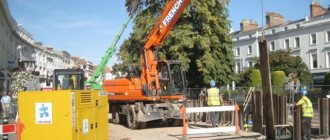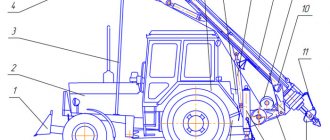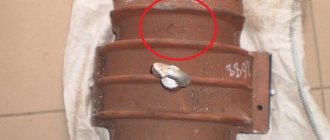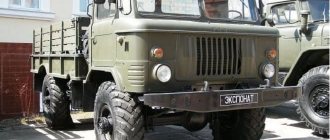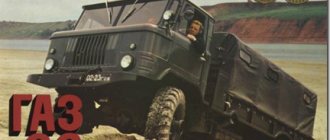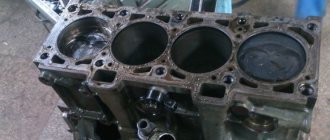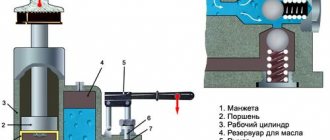Scope of use of the pit drill
The main purpose of the BKM-317 hole drill is vertical drilling of holes in unfrozen soils of categories 1-4 for:
BKM-317
- installation of power line poles;
- arrangement of pile fields;
- installation of pipelines;
- installation of enclosing structures, road signs;
- tree planting;
- other needs of public utilities, construction and energy industries.
Drilling and crane machines BKM-317 are multifunctional and combine the capabilities of a drilling rig, a crane and an aerial platform. Simultaneously with drilling, the unit can install supports and metal structures. Permissible temperature conditions for operating the machine: -40…+40 degrees.
How does BKM-317 work?
The BKM-317 drilling and crane unit is installed on the chassis of a GAZ-33081 truck, which provides high maneuverability and maneuverability of the equipment in densely built-up and off-road conditions.
The machine's cabin is designed with a single-row or double-row seating arrangement, which allows the work crew to be delivered to the site without the involvement of additional transport. The main working body is a bladed drill.
Modifications of the BMK-317 machine are offered in two configuration options:
Supports and drill BKM-317
- with a hydraulic feed drive and a mechanical drive for rotating the drill - the mechanics are unpretentious in maintenance, have a high endurance reserve, but provide only three rotation speeds of the drilling equipment;
- with hydraulic drive of all working parts and systems - with the help of hydraulics, stepless speed control occurs, which significantly reduces the load on the engine and transmission and preserves the life of these most important machine components.
Additionally, the BMK-317 is equipped with a reverse-type winch, used for installing supports into holes prepared in the ground and other crane manipulations. It is possible to install an ADU (additional securing device), which ensures the safety of installers when performing high-altitude work on dilapidated support elements.
The guard rail ensures operator safety. A metal ladder provides convenient access to the main units and components of the drilling and crane machine.
General device. Units and mechanisms
Yamobur is a unit for vertical drilling with a mechanical-hydraulic drive of the executive equipment. The installation's transmission provides several drill rotation speed modes and adjustable stepless supply of the tool to the bottom of the well.
The parameters of revolutions and axial movement of the drilling device are selected based on the density of the soil rocks. The chassis provides maneuverability and maneuverability of the vehicle, placement of equipment and work crew.
Modular design mast. The tubular cross-section of the device made it possible to place the moving parts of the drive in it and make it the basis for mounting the crane mechanism and replaceable equipment (pile driver, manipulator, etc.). The mast is enclosed by a grille, which prevents injury to the operator and protects the equipment.
Important! The device for transmitting rotation to the drilling tool can be equipped with a mechanical or hydraulic drive. The latter allows for stepless speed control. The mechanics are simple, unpretentious, but it produces only three fixed rotation speeds.
Modular crane equipment is equipped with a 2-ton winch with a reversible capacity. Used for installing support elements into a prepared well.
Outriggers provide stability to the rig when drilling and working with loads.
Technical parameters (operational indicators)
The performance characteristics of the machine allow you to quickly and efficiently carry out drilling and crane work:
Drill device for BMK-317
- overall dimensions of the basic model BKM-317 (length/width/height) – 7.05*2.5*3.27 m;
- total weight - 5.95 tons;
- wheel formula – 4*4;
- type of drilling – cyclic;
- maximum drilling depth – 3 m;
- well diameter – up to 80 cm;
- drilling angle – 60-95 degrees;
- crane lifting capacity (mechanical drive/hydraulic drive) – up to 1250/2000 kg;
- maximum torque – 4900-5900 (depending on modification).
Main characteristics
The drilling machine has a number of basic technical characteristics. Based on them, equipment is selected for a particular activity:
- Drilling depth. For non-rotating machines this value ranges from two to three meters. For rotary ones - from 10 m to 15 m.
- Drilling angle. Typically, it is in the range from 620 to 1050.
- Well diameter. For non-rotating ones, the standard value ranges from 360 mm to 600 mm. For rotary ones - up to 630 mm.
- Load capacity ranges from 1.25 to 3 tons.
- The maximum length of the lifting load is up to 12 meters.
Depending on the technical specifications, the most suitable drilling machine is selected.
View gallery
An important factor in choosing is the transport base. In conditions with relief soil, a tractor-based option is often chosen
For urban conditions - based on a car.
Crane drilling machine frame
The BKM-317 frame is a welded metal structure fixed to the chassis, onto which the working systems and components of the drilling and crane machine are installed:
Frame BKM-317
- mast hydraulic cylinder – for lifting and fixing the mast in working position;
- transfer case with winch - for changing the rotation speed and direction of the drill;
- oil tank;
- cardan shafts - for transmitting rotational motion to BMK-317 drilling equipment;
- hydraulic pump – to drive equipment;
- hydraulic jacks – ensure the stability of the installation during drilling and crane operations;
- control panel - facilitates the process of monitoring equipment and managing technological operations.
Power unit
The movement of the automobile chassis and the operation of the BKM actuators are provided by a four-stroke diesel engine with an in-line arrangement of 4 working cylinders.
Injection of the combustible mixture is direct. The unit is produced by the Minsk Motor Plant in accordance with Euro-3 requirements and develops a power of 86.2 kW.
When drilling equipment is operating, torque is removed from the chassis transfer case shaft. The mechanical drive from the box to the vehicle's chassis is turned off and blocked.
Mast of special equipment BKM-317
It is a supporting structure for the accompanying equipment of the BKM-317 machine:
- crane unit;
- pile driver;
- unfastening device.
The tubular modular design of the mast significantly speeds up and simplifies the installation of the drilling and crane rig. The moving parts located in it are reliably protected from external influences and damage.
Mast BKM-317
Equipment hydraulic system
The BMK-317 hydraulic system is designed for:
- transferring the drilling unit from the transport position to the working position;
- stepless transmission of reciprocating motion of the executive body and its supply to the bottom of the well;
- control of hydraulic jacks.
Adjustable hydraulics allow you to select the optimal drilling mode, depending on the task and soil characteristics.
Trench cutter on BKM-317
Equipment that complements the capabilities of the unit
- The DRU-01 kit ensures the safety of electricians on dilapidated support elements of communication and power lines.
The gripping mechanism fixes the support, which prevents its destruction or falling during repair work. Capable of leveling the support element installed in the well before final backfilling. The quick-release fastener mechanism makes it possible to effectively use DRU-01 in line repairs. - Equipment for installing pile elements DSO-01 mechanizes the process of forming pile fields. A diesel hammer mounted on a rod has a working part mass of 250 kg.
- Dismantling equipment DPO-01 removes supports and piles from wells. The traction effect is provided by a hydraulic cylinder operating from the standard hydraulic system of the unit.
- The Gesan GS 210 DCH petrol generator ensures manual arc welding. It can be used as a backup source of power supply.
Types of drills for BKM-317
Depending on the type and properties of the soil, various types of drills are used for BKM-317:
- bladed - most common for weak and dense soils;
- conical - with replaceable round teeth (for processing rocks, including marble and limestone);
- core - for working on hard rocks.
The GAZ-based drilling and crane machine is characterized by high maneuverability and unpretentiousness. The build quality and technical characteristics allow the equipment to be used in difficult working conditions. Unified spare parts and components provide a high degree of maintainability. The ability to select the optimal mode and additional crane equipment make the machine universal for a wide range of drilling operations with various types of soil.
Drilling tool rotation drive
A vertical shaft (up to 5 m or more in length) - a square or hexagonal profile rod along which a gearbox (for example, a rotator) moves - transmits rotation from a stationary mechanism (gearbox) to a movable one (rotator).
It is used in rotation mechanisms of drilling tools when using schemes with movable rotators with an output shaft. Rotators rotate the drill rod or drilling tool. They come in two types: fixed through (rotary) and movable with an output shaft. The fixed rotator is rigidly fixed at the bottom of the mast, and the drill rod is freely mixed in its hole. The movable rotator is installed on the mast guides with the possibility of free movement along them. The output shaft is rigidly connected to the drill rod or drilling tool.
Fixed pass-through rotators are available in single-stage with bevel or spur gears and two-stage with bevel-cylindrical or spur gear only.
Let's consider the most common stationary single-stage rotator through passage with a bevel gear, used in drilling and crane machines BM-205, BM-202A, BM-302A, BM-305 (Fig. 22).
Rice. 22. Fixed pass-through rotator (BM-302A):
Crankcase 2 houses the driving 29 and driven 18 bevel gears. Gear 29 is mounted on two bearings 27, seated in cup 26, and bearing 30. The splined shank of gear 29 is connected to a splined sleeve 22, ending with a flange, which is connected to the driveshaft of the transfer case.
Gear 18 is fastened with rivets to bushing 19, which is installed in bearings 4 and 14, located in cover 6 and housing 2, respectively. Inside bushing 19, textolite liners 20 are installed in grooves, which contact the drill rod (not shown in the figure) located inside the bushing 19. Gaskets 1, 3, 7, 15, 25, 28 are installed at the joints. From the cardan shaft (not shown in the figure), rotation is transmitted to bushing 22, then to gears 29 and 18, bushing 19 and the drill rod. Lubricant is poured into the rotator through a hole closed by plug 11 and breather 10, which communicates the cavity of the rotator with the atmosphere and eliminates the possibility of increasing pressure in it. To prevent lubricant leakage from the rotator, cuffs 5, 13 and 23 are installed in the cover 6 and flanges 12 and 24.
A dirt cleaner 31 is attached to the rotator from below. In the body of the dirt cleaner 31 there is a glass 32 with a split disk 33, which has a flat spring 34 on the outside and a square ring 35 on the inside. A dirt cleaning bag installed in the glass 32, consisting of rings 40 and a solid disk 39, is pressed against the liner 20 and a split disk 37 with an external coil spring 36. The dirt cleaning bag is clamped by a flange 38, which is bolted to the cup 32 and the crankcase 2.
The rotator is mounted on the machine frame (not shown in the figure) using support 21 with the ability to rotate. The support 21 is rigidly connected with bolts to the crankcase 2. The machine mast is attached to the top of the rotator to the cover 6. The position of the housing 2 and flanges 12 and 16 is fixed with pins 17. The fastening of gears 18 and 29 is adjusted using gaskets 1 and 28, and the clearances in bearings 27 are adjusted with gasket 25.
